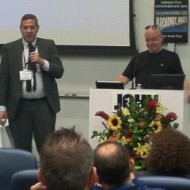SIBMAS-TLA Conference: Sizing Up Day Three
Keynote Marvin Taylor from the Fales Library at NYU evoked the work of theorists Ann Cvetkovich (An Archive of Feelings: Trauma, Sexuality, and Lesbian Public Cultures) and Diana Taylor (The Archive and the Repertoire: Performing Cultural Memory in the Americas) ) to frame his discussion, focusing on aspects of NYU’s Downtown Collection which features work by prominent artists, activists, musicians and performers in New York’s downtown scene. In his keynote, Taylor posed the question, how do we as archivists/curators preserve what isn’t written down? Citing objects that do not rely on text, Taylor spoke about his work around object collection, using David Wojnarowicz’s “Magic Box” and its contents as a tipping point for upending notions around rules of archives and the types of materials retained. Taylor cited the work of Michel Foucault and his interest in the physicality of things, and the ties between objective and subjective meaning that viewers respond to when engaging with physical objects. Taylor spoke about his research on black leather jackets, looking at object provenance, and the masculinity/sexuality attached to this weighted inanimate object. Taylor’s talk focused on the embodied object and the experience those objects elicit, urging archivists, librarians and curators to collect as broadly as possible in order to provide the largest experience for users; to move away from knee-jerk digitization projects; and to focus on preservation of moving image rather than on paper collections, citing the work of the Variable Media Project as a standard bearer in that area.
Plenary session participant Aurélie Rezzouk from the Université de Rouen, Rouen spoke about the ways that exhibition of materials creates singular point of view, stating that re-creations of past performance within embodied objects associated with an event serve as re-ownership of the past experience. Given that performances truly cannot be performed again, the recapturing of theatre history can be challenging as the nature of exhibition is entirely driven by point-of-view: the institution staging the exhibit manipulates the objects to elicit a specific experience out of the audience, one that is generally separate and unique from the actual theatrical experience. Many of the questions Aurélie put forward were related to what happens between visitor and subject during exhibition. What is the rhythm, the tempo created when remnants of the stage are presented out of order, out of context? How do these objects serve as imprints of the moment, witnesses to an event that the exhibition visitor may or may not have witnessed him/herself?
Sophie Johns (Bristol University Theatre Collection, Bristol) focused on visitors’ responses to theatre objects, stating that there is no definitive authentication of objects by archivists/curators, but rather each person who interacts with the objects determines his/her own story. Johns argued that oral history interviews and historicity around objects can lend context and provide spatial/time identifiers, but the “thingness” or the “stuff” must involve cultural re-encoding to instill meaning given that interpretation between thing and meaning is often subjective. Johns conducted a test case for her dissertation whereby a group of visitors were provided a collection box containing materials related to theatre, theatre practitioners, etc. She used the objects to serve as informants of intent—what the objects mean to the disconnected future user, what social/political/economic inferences can (or will) be made, juxtaposed against inferences made by the collector/curator. She argues that the act of collecting itself serves as a form of performance, the historicity of informed experience directs the collector to aggregate materials that he/she believes exemplify the experience, the sensation, etc., forcing the collector to assign meaning to objects that, in and of themselves, are unable to express memory, experience, purpose. Therefore exhibition repurposes artifacts and defines new context, assigning meaning, intent, and experience anew with each subsequent visitor.
Lastly, Morgen Stevens-Garmon, the Theater Archivist at the Museum of the City of New York, New York, summarized the overarching tendency in theatre documentation to give priority to the text—scripts are generally maintained but the countless other materials are not, so how do we as keepers of these objects provide entrance to new generations of theatre practitioners and scholars? How do we help them think about performance beyond the text? Morgen provided a step-by-step processing around a large digitization project aimed at doing just that: providing access to some 30,000 photos, broadsheets, and ephemera from the Museum of the City of New York’s theatre collection in order to help change the way we think about performance. Morgen discussed the obstacles inherent in linking existing cataloging software to new ones and the ways that tools are used administratively and by the end user, often to very different ends.
Tiffany Nixon
Roundabout Theatre Company

